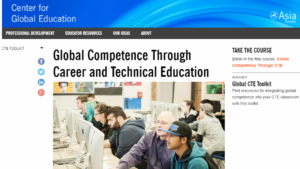Increasing numbers of careers are requiring global competence, facility with world languages and cultures, and the ability to work in global teams. Just consider these facts:
- Ninety-seven percent of business executives identified intercultural skills, or being “comfortable working with colleagues, customers, and/or clients from diverse cultural backgrounds,” as important, including 63 percent who believe these skills are “very important.”
- Another study found that 80 percent of U.S. executives agree that their businesses would increase if staff had international experience.
- An international study conducted in more than 100 countries found that employers increasingly need employees who “are not only technically proficient but also culturally astute and able to thrive in a global work environment.” The study also identified the ability to understand different cultural contexts and viewpoints, respect for others, and knowledge of a foreign language as key skills that employers are using and will continue to use to evaluate and retain employees.
At a fundamental level, the goal of Career Technical Education (CTE) is to prepare students for successful careers, and CTE programs should provide opportunities for students to learn and apply global competencies in order for students to successfully participate in the American economy and beyond.
 While this may feel like a natural fit, too few educators have the training or resources they need to teach the global aspects of their career pathways. To address this challenge and support the field, Asia Society, together with the Association for Career and Technical Education (ACTE) and Advance CTE, developed a free professional development course and set of tools: Global Competence Through Career and Technical Education.
While this may feel like a natural fit, too few educators have the training or resources they need to teach the global aspects of their career pathways. To address this challenge and support the field, Asia Society, together with the Association for Career and Technical Education (ACTE) and Advance CTE, developed a free professional development course and set of tools: Global Competence Through Career and Technical Education.
This web-based, interactive course and related tools are designed to help CTE educators integrate global content and skills into what they are already teaching in their classrooms to prepare students for the global world of work. The tools – which can be used within the context of the course but are also available on their own – including career-planning lesson plans and worksheets, videos providing global competencies in a range of career clusters, sample global CTE classroom projects, project management resources, and more. One of the main features of the online module is that educators not only get to test out these tools, they also have the opportunity to share their experiences with other participants across the country.
As a partner in this work, Advance CTE sees a great opportunity for states to embed this resources in their own professional development offerings. So how can you learn more?
- Check out the tools yourself and see what they’re all about!
- Share the website and resources with administrators and educators in your state.
- Consider your own statewide vision for CTE and where global competency does and should support that vision.
- Contact Heather Singmaster (HSingmaster@asiasociety.org) or Kate Kreamer (kkreamer@careertech.org) for more information on how to promote and implement the resources.
As states increasingly prioritize career readiness and CTE – including the 35 states that included career readiness indicators in their Every Student Succeeds Act (ESSA) plans, the 10 states participating in New Skills for Youth, and 49 states and DC that passed policies related to career readiness in 2017 alone – this is a critical moment in time to ensure that CTE and related experiences and pathways prepare students for success not only in their own communities but in the entire global community.
Kate Kreamer, Deputy Executive Director
Tags: global competition

